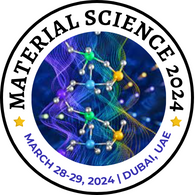Sessions & Tracks
Session on Advances in Nanomaterials and Nanotechnology
Advances in Nanomaterials and Nanotechnology have revolutionized the field of materials science, opening up a world of possibilities for various applications. This session will focus on the latest breakthroughs and cutting-edge research in nanomaterials synthesis, design, and characterization. Attendees will explore the diverse range of nanomaterials, including nanoparticles, nanocomposites, nanowires, and nanotubes, and their unique properties that enable novel functionalities. Moreover, the session will delve into nanotechnology's impact on various industries, such as electronics, healthcare, energy, and environmental sustainability. The conference will provide a platform for researchers, scientists, and industry experts to present their findings and discuss the challenges and opportunities in this rapidly evolving field. Key topics include nanomaterials for drug delivery, nanoelectronics, nanosensors, and nanophotonics. Through interdisciplinary discussions and knowledge exchange, the session aims to foster collaborations, inspire innovative ideas, and pave the way for the next generation of nanomaterials and nanotechnology applications.
Session on Biomaterials and Tissue Engineering
Biomaterials and Tissue Engineering will showcase groundbreaking research and advancements in the field of biomaterials and its application in tissue engineering. This session will explore the development of biocompatible materials and scaffolds that mimic the extracellular matrix, promoting cell adhesion, growth, and tissue regeneration. Attendees will have the opportunity to learn about the latest strategies in tissue engineering, including 3D bioprinting and organ-on-a-chip technologies, which hold promise for personalized medicine and drug testing. Additionally, the session will cover biomaterials for medical implants, wound healing, and tissue repair, addressing challenges and future directions in these areas. Experts in the field will present their studies on tissue-specific biomaterials, bioactive coatings, and the integration of cells and biological factors to create functional tissues. The session aims to foster collaborations between materials scientists, engineers, biologists, and clinicians, accelerating the translation of research findings into clinical applications and improving the quality of life for patients through tissue engineering innovations.
Session on Sustainable Materials for a Greener Future
Sustainable Materials for a Greener Future will focus on the development and utilization of eco-friendly materials to address environmental challenges and promote sustainable practices. This session aims to highlight the latest research and innovations in sustainable materials that have the potential to reduce the carbon footprint, minimize waste, and conserve natural resources. Attendees will have the opportunity to learn about biodegradable materials, recycled and upcycled materials, and bio-based materials that offer alternatives to traditional resources. The session will explore their applications in various industries, including construction, packaging, and consumer products, contributing to a circular economy and reducing environmental impacts. Experts in sustainable materials will present their findings on life cycle assessments, eco-design principles, and sustainable manufacturing processes. Discussions will revolve around challenges and opportunities in scaling up the use of sustainable materials, and the potential role of advanced technologies, such as artificial intelligence and materials informatics, in accelerating sustainable material development. Overall, the session aims to inspire collaboration and drive advancements in sustainable materials research, paving the way for a greener and more environmentally conscious future.
Session on Smart Materials and Intelligent Systems
Smart Materials and Intelligent Systems will delve into the exciting world of materials with responsive properties and their integration into intelligent systems. Attendees will explore the latest advancements in smart materials, including shape-memory alloys, piezoelectric materials, and magneto strictive materials, which can change their properties in response to external stimuli. This session will also showcase the development of intelligent systems that leverage smart materials to achieve unprecedented functionalities. These systems may include sensors, actuators, and adaptive structures that can sense and respond to environmental changes. Researchers, scientists, and engineers will present their work on smart materials and intelligent systems in various applications, such as robotics, aerospace, healthcare, and civil engineering. The session will provide a platform for discussions on challenges and opportunities in the field, with a focus on scalability, reliability, and commercialization. The ultimate goal of this session is to inspire collaboration and foster innovation in the development of smart materials and intelligent systems, driving advancements that have the potential to transform numerous industries and improve our daily lives.
Session on Materials for Energy and Environmental Sustainability
Materials for Energy and Environmental Sustainability" will showcase the latest developments in materials science aimed at addressing the critical challenges of energy generation, storage, and environmental preservation. Researchers and experts will present their cutting-edge research on advanced materials for renewable energy technologies, such as solar cells, fuel cells, and wind energy harvesting devices. Additionally, the session will explore materials for energy storage, including batteries and super capacitors, which play a crucial role in enabling the integration of renewable energy sources into the grid and ensuring a stable energy supply. Moreover, the conference will highlight materials for environmental sustainability, such as those used in water purification, air pollution control, and carbon capture and storage. Attendees will learn about the role of materials in mitigating environmental impacts and promoting a cleaner and more sustainable future. Through this session, attendees will gain insights into the potential of materials science in driving advancements in energy and environmental sustainability, contributing to a greener and more sustainable world. The session aims to foster collaborations and inspire innovative solutions to meet the global challenges of energy and environmental sustainability.
Session on Additive Manufacturing and 3D Printing
Additive Manufacturing and 3D Printing" will delve into the transformative world of advanced manufacturing techniques that are revolutionizing industries. Attendees will explore the latest innovations in 3D printing and additive manufacturing, which enable the precise fabrication of complex and customized components with reduced waste. Experts will present cutting-edge research on materials used in additive manufacturing, including polymers, metals, ceramics, and composites, and their applications in aerospace, automotive, healthcare, and consumer goods sectors. The session will also discuss the potential of 3D printing in creating patient-specific medical devices, prosthetics, and tissue-engineered constructs, paving the way for personalized medicine and improved patient outcomes. Attendees will learn about the challenges and opportunities in additive manufacturing, including scalability, post-processing techniques, and quality control. By fostering interdisciplinary discussions, this session aims to inspire collaboration and drive advancements in additive manufacturing, pushing the boundaries of design and production possibilities, and shaping the future of manufacturing across various industries.
Session on Emerging Functional Materials for Electronics and Photonics
Emerging Functional Materials for Electronics and Photonics" will unveil the latest breakthroughs in materials science that are propelling the electronics and photonics industries forward. Attendees will explore novel functional materials with unique electronic, optical, and photonic properties that hold promise for next-generation devices and technologies. This session will cover a diverse range of materials, including 2D materials, perovskites, quantum dots, and organic semiconductors, and their applications in high-performance transistors, sensors, displays, and photo detectors. Experts will present cutting-edge research on the synthesis, characterization, and performance optimization of these materials, providing insights into their potential in enabling faster, smaller, and more energy-efficient electronic and photonic devices. The conference aims to foster collaborations among researchers, engineers, and industry professionals to accelerate the development and commercialization of emerging functional materials for electronics and photonics. Through this session, attendees will gain a deeper understanding of the evolving landscape of functional materials and their transformative impact on the electronics and photonics industries.
Session on Computational Materials Science and Modeling
Computational Materials Science and Modeling" will explore the cutting-edge field of virtual materials design and simulation. Attendees will delve into the power of computational techniques in understanding and predicting the properties, behavior, and interactions of materials at the atomic and molecular levels. This session will cover various computational methods, such as density functional theory (DFT), molecular dynamics (MD), and Monte Carlo simulations, and their applications in studying a wide range of materials, from metals and semiconductors to biomaterials and nanomaterials. Experts will present their research on materials informatics, machine learning, and data-driven approaches, highlighting how these methods expedite materials discovery and optimization. Moreover, discussions will revolve around the integration of experimental data and theoretical calculations to achieve a more comprehensive understanding of materials behavior. By fostering collaboration between computational scientists and experimentalists, this session aims to advance the field of materials science and accelerate materials design and discovery, opening new avenues for innovative technologies and applications.
Session on Advanced Characterization Techniques for Materials
Advanced Characterization Techniques for Materials" will delve into the latest developments in materials characterization methods that enable researchers to gain deeper insights into the structure, composition, and properties of materials. This session will cover a wide range of advanced characterization techniques, including scanning electron microscopy (SEM), transmission electron microscopy (TEM), X-ray diffraction (XRD), spectroscopy (XPS, FTIR, Raman), atomic force microscopy (AFM), and various surface analysis techniques. Experts will present their research on how these techniques can be used to investigate nanoscale and microscale features of materials, analyze crystallographic structures, identify chemical compositions, and study surface properties. The conference will provide a platform for discussions on the complementary nature of different characterization techniques and their role in elucidating materials' behavior under different conditions. By fostering collaboration among researchers and industry professionals, this session aims to drive advancements in materials characterization, enhance the understanding of material properties, and pave the way for the development of innovative materials with tailored functionalities for various applications.
Session on Materials for Biomedical Applications
Materials for Biomedical Applications" will highlight the pivotal role of materials science in advancing healthcare and biomedicine. Attendees will explore the latest developments in biomaterials that are designed to interact with biological systems for diagnostic, therapeutic, and regenerative purposes. This session will cover a wide range of materials, including biocompatible polymers, bioactive ceramics, metallic implants, and biodegradable scaffolds. Experts will present their research on how these materials are used in medical devices, tissue engineering, drug delivery systems, and implants. Moreover, the conference will focus on materials for personalized medicine and precision healthcare, including bioinks for 3D bioprinting and nanomaterials for targeted drug delivery. The session aims to foster collaboration between materials scientists, biomedical engineers, and clinicians to accelerate the translation of research findings into clinical applications. Discussions will revolve around challenges and opportunities in developing safe and effective materials for biomedical applications, ensuring biocompatibility, and meeting regulatory standards. Overall, this session strives to inspire innovation in materials for biomedical applications, improving patient outcomes and contributing to the advancement of healthcare technologies.
Session on Novel Materials for Energy Storage and Conversion
Novel Materials for Energy Storage and Conversion" will showcase the latest advancements in materials science that are driving breakthroughs in energy storage and conversion technologies. Attendees will explore novel materials designed to enhance the efficiency, capacity, and sustainability of energy storage systems, such as batteries and supercapacitors. Experts will present their research on advanced electrode materials, electrolytes, and separators, aiming to overcome the limitations of traditional energy storage technologies and enable the integration of renewable energy sources into the grid. Moreover, the session will cover materials for energy conversion applications, including photovoltaics, thermoelectrics, and catalysis. Attendees will learn about cutting-edge materials and structures that hold promise for efficient energy conversion and improved overall energy utilization. Discussions will revolve around challenges and opportunities in scaling up the use of novel materials for energy storage and conversion, as well as exploring the potential of emerging materials, such as perovskites and 2D materials, in this domain. Through this session, researchers, scientists, and industry professionals aim to foster collaboration and innovation, accelerating the development of next-generation materials for sustainable energy storage and conversion, and ultimately contributing to a more sustainable and greener future.
Session on Materials for Aerospace and Automotive Applications
Materials for Aerospace and Automotive Applications" will focus on the critical role of materials science in advancing the aerospace and automotive industries. Attendees will explore the latest developments in materials that offer lightweight, high-performance, and durable solutions for these demanding sectors. This session will cover a wide range of materials, including advanced composites, high-strength alloys, titanium, and superalloys, all of which are used to reduce weight while maintaining structural integrity in aerospace and automotive components. Experts will present their research on materials that can withstand extreme conditions, such as high temperatures, corrosion, and mechanical stresses, in aerospace propulsion systems and automotive engines. Moreover, the session will highlight the importance of sustainable and eco-friendly materials in reducing the environmental impact of aerospace and automotive operations. Discussions will revolve around advancements in additive manufacturing for aerospace and automotive applications, enabling the rapid prototyping and production of complex components. By fostering collaboration between materials scientists, engineers, and industry leaders, this session aims to drive innovations in materials for aerospace and automotive applications, paving the way for more fuel-efficient, safer, and sustainable transportation systems.
Session on Materials for Optoelectronic Devices
Materials for Optoelectronic Devices" will delve into the exciting field of materials science that underpins the development of cutting-edge optoelectronic technologies. Attendees will explore materials with unique electronic and optical properties that enable the conversion of light into electricity and vice versa, crucial for devices such as lasers, light-emitting diodes (LEDs), solar cells, and photodetectors. This session will cover a diverse range of materials, including semiconductors, quantum dots, perovskites, and organic materials, all of which play a pivotal role in enhancing the performance and efficiency of optoelectronic devices. Experts will present their research on materials engineering, interface control, and device fabrication techniques, aiming to optimize the performance and stability of optoelectronic devices. Moreover, the session will highlight emerging materials, such as 2D materials and nanomaterials, that hold promise for the development of next-generation optoelectronic devices with unprecedented functionalities. Discussions will revolve around challenges and opportunities in commercializing optoelectronic materials and devices for various applications, including communication, sensing, imaging, and renewable energy generation. Through this session, researchers, scientists, and industry professionals aim to foster collaboration, accelerate materials discovery, and drive innovations in materials for optoelectronic devices, shaping the future of photonics and optoelectronics technology.
Session on Green Synthesis and Processing of Materials
Green Synthesis and Processing of Materials" will focus on sustainable and environmentally friendly approaches to fabricating materials. Attendees will explore innovative methods that minimize the use of hazardous chemicals, reduce energy consumption, and promote eco-friendly manufacturing processes. This session will cover green synthesis techniques for various materials, including nanoparticles, polymers, composites, and biomaterials. Experts will present their research on using natural extracts, green solvents, and renewable resources as alternatives to traditional synthesis methods. Moreover, the conference will highlight the importance of reducing waste and adopting recycling strategies in materials processing, contributing to a circular economy. Discussions will revolve around the challenges and opportunities in scaling up green synthesis and processing methods for large-scale production while maintaining material quality and performance. The session aims to inspire researchers and industry professionals to adopt greener practices in materials fabrication, leading to more sustainable products and technologies with reduced environmental impact. By fostering collaboration and knowledge exchange, this session seeks to drive advancements in green materials synthesis and processing, paving the way for a more sustainable and greener future.
Session on Materials for Sensing and Actuation
Materials for Sensing and Actuation" will explore the fascinating field of materials science that enables the development of smart sensors and actuators. Attendees will delve into the latest advancements in materials that possess responsive properties, allowing them to detect and respond to changes in their environment. This session will cover a diverse range of materials, including piezoelectric materials, shape-memory alloys, electro active polymers, and magneto strictive materials, all of which are used in sensors and actuators for various applications. Experts will present their research on the design and fabrication of materials for sensing physical, chemical, and biological signals, enabling applications in healthcare, robotics, aerospace, and consumer electronics. Moreover, discussions will revolve around materials for actuation, where these materials can be utilized to convert electrical, thermal, or magnetic signals into mechanical motion, enabling the development of responsive and adaptive systems. Through this session, attendees will gain insights into the potential of materials science in driving advancements in sensing and actuation technologies, leading to innovative applications that improve our daily lives and enable the development of cutting-edge devices and systems.
Session on Materials for Advanced Coatings and Surface Engineering
Advanced coatings and surface engineering play a crucial role in enhancing the performance and durability of various materials used in industries ranging from aerospace to automotive and electronics. These cutting-edge materials are designed to withstand extreme conditions, provide superior protection against corrosion, wear, and abrasion, and improve overall efficiency. One of the key materials used in advanced coatings is nanomaterials. Nanotechnology enables precise control over the structure and composition of coatings, leading to exceptional properties like super hydrophobicity, self-cleaning surfaces, and enhanced heat resistance. Additionally, advanced composites, such as carbon fiber-reinforced polymers, offer high strength-to-weight ratios and superior mechanical properties, making them ideal candidates for coating applications. Surface engineering techniques, such as plasma spraying, chemical vapor deposition, and physical vapor deposition, allow for the deposition of thin films with precise control over thickness and microstructure. These techniques enhance material surface properties, making them resistant to wear, corrosion, and high temperatures. Moreover, advanced coatings are used to tailor specific functionalities, such as anti-reflective coatings for optical devices, thermal barrier coatings for gas turbine engines, and bioactive coatings for medical implants. The continuous development and adoption of materials for advanced coatings and surface engineering contribute significantly to modernizing industries, extending material lifetimes, and reducing maintenance costs, ultimately paving the way for more sustainable and efficient technologies. Researchers and engineers are continually pushing the boundaries to discover new materials and techniques, ensuring a brighter future for innovative coatings and surface engineering applications.
Session on Materials for Structural Applications and Lightweight Design
Materials for structural applications and lightweight design are critical in various industries, including aerospace, automotive, construction, and renewable energy. The demand for high-strength materials with reduced weight is driven by the need for fuel efficiency, increased payload capacity, and improved overall performance. Several materials have emerged as key players in meeting these requirements: Carbon Fiber Composites: Carbon fiber-reinforced polymers offer exceptional strength-to-weight ratios, making them ideal for lightweight structures in aerospace and automotive industries. These composites can replace traditional materials like steel and aluminum, resulting in fuel savings and increased structural integrity. Aluminum Alloys: Aluminum alloys combine low density with good mechanical properties, making them popular choices for lightweight structural components in various applications. They are extensively used in aircraft, automotive frames, and consumer electronics. Titanium Alloys: Titanium's excellent strength and corrosion resistance make it an ideal choice for both aerospace and medical applications. Though more expensive than aluminum, it offers better performance in high-temperature and aggressive environments. Advanced High-Strength Steel: New steel formulations, like high-strength low-alloy (HSLA) and advanced high-strength steel (AHSS), provide enhanced strength without a significant increase in weight. These materials find applications in automotive chassis and structural components. Polymer Matrix Composites (PMCs): Besides carbon fiber composites, PMCs encompass a variety of materials reinforced with fibers like glass, aramid, or natural fibers. PMCs offer high strength and low weight, making them suitable for automotive and sporting goods industries.
Session on Materials for Nanoelectronics and Quantum Technologies
Materials play a crucial role in the advancement of nano electronics and quantum technologies, paving the way for transformative applications in computing, sensing, and communication. These cutting-edge materials offer unique quantum properties that enable the development of faster, more energy-efficient devices with unprecedented functionalities. Semiconductor nanomaterials, such as quantum dots and nanowires, exhibit size-dependent quantum confinement, making them ideal candidates for quantum dot-based lasers and single-photon sources. Graphene, with its remarkable electronic and mechanical properties, holds promise for high-speed electronics and quantum information processing. Topological insulators, superconductors, and nitrogen-vacancy centers in diamonds are critical in quantum computing and quantum sensing, as they offer intriguing quantum states and quantum bits manipulation. Additionally, 2D materials and quantum dots enable the creation of nanoelectronic devices and quantum sensors. The exploration of quantum materials, spintronics materials, and quantum well hetero structures opens up new possibilities for spin-based computing and emergent quantum phenomena. As researchers continue to push the boundaries of materials science, these innovative materials will shape the future of nanoelectronics and quantum technologies, propelling us into a realm of unprecedented computational power and transformative quantum applications.
Session on Materials for Renewable Energy Technologies
Renewable energy technologies are at the forefront of the global shift towards sustainable and clean energy sources. The development and utilization of advanced materials play a pivotal role in driving the efficiency and effectiveness of these technologies. Several materials have emerged as key components in various renewable energy applications: Photovoltaic Cells: High-performance materials like crystalline silicon, thin-film solar cells, and emerging perovskite materials are used to convert sunlight into electricity efficiently. Wind Turbines: Strong and lightweight materials, such as advanced composites and high-strength alloys, are employed to manufacture turbine blades that can withstand harsh wind conditions while maximizing energy capture. Energy Storage: Materials like lithium-ion batteries and emerging solid-state batteries enable efficient and reliable energy storage for renewable sources, ensuring continuous power supply even during fluctuations. Biomass and Biofuels: Biomass materials and biofuels, derived from organic matter, provide a renewable and sustainable source of energy for power generation and transportation. Hydropower: Materials used in the construction of dams and turbines, such as concrete, steel, and composite materials, ensure the durability and longevity of hydropower infrastructure. Geothermal Systems: High-temperature-resistant materials are vital for the effective functioning of geothermal power plants, where heat from the Earth's core is harnessed to generate electricity. Tidal and Wave Energy: Corrosion-resistant materials are essential in tidal and wave energy converters, which operate in harsh marine environments.
Session on Materials for Sustainable Construction and Infrastructure Development
Sustainable construction and infrastructure development are vital components of the global effort to build a greener and more resilient future. The choice of materials in these projects plays a crucial role in minimizing environmental impact and optimizing resource efficiency. Several materials have emerged as cornerstones of sustainable construction: Recycled and Reclaimed Materials: Using recycled concrete, steel, and wood reduces waste and minimizes the demand for new raw materials, leading to a more circular economy. Green Concrete: Green concrete incorporates industrial by-products like fly ash, slag, or silica fume, reducing carbon emissions and enhancing durability. Sustainable Timber: Sustainably sourced timber and engineered wood products help to preserve forests and provide renewable alternatives to traditional construction materials. Energy-Efficient Insulation: Advanced insulation materials, such as cellulose, aerogels, and recycled cotton, reduce energy consumption in buildings and improve indoor comfort. High-Performance Glass: Energy-efficient windows and glazing materials optimize natural lighting while minimizing heat loss or gain. Eco-Friendly Pavements: Permeable pavements, made from materials like porous asphalt or interlocking concrete pavers, allow better storm water management and reduce heat island effects. Green Roofing: Living roofs with vegetation not only insulate buildings but also absorb rainwater, mitigating the urban heat island effect and enhancing biodiversity. Carbon-Neutral Materials: The development of low-carbon cement, bio plastics, and other carbon-neutral materials strives to reduce the carbon footprint of construction.











